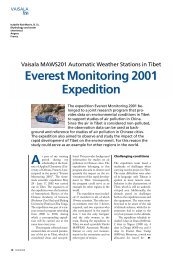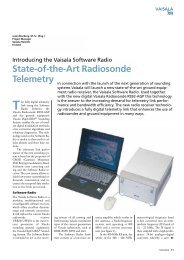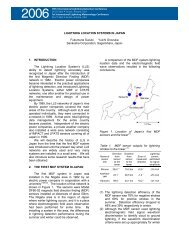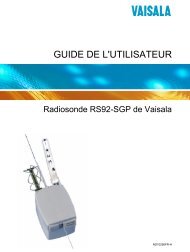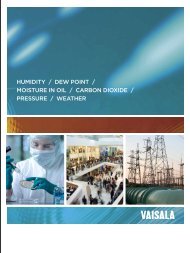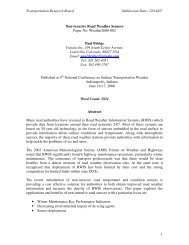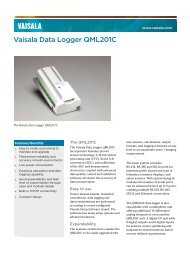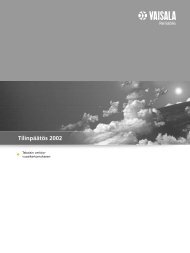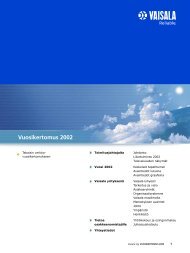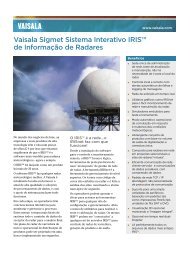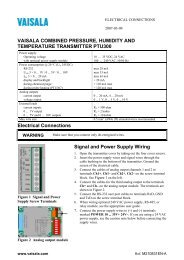humidity / dew point / tempeRAtuRe / moistuRe in oil ... - Vaisala
humidity / dew point / tempeRAtuRe / moistuRe in oil ... - Vaisala
humidity / dew point / tempeRAtuRe / moistuRe in oil ... - Vaisala
You also want an ePaper? Increase the reach of your titles
YUMPU automatically turns print PDFs into web optimized ePapers that Google loves.
If saturation vapor pressure is<br />
reached <strong>in</strong> air or <strong>in</strong> a gas mixture,<br />
the <strong>in</strong>troduction of additional water<br />
vapor requires that an equal amount<br />
condenses out of the gas as a liquid<br />
or a solid. A psychrometric chart<br />
shows graphically the relation<br />
between saturation vapor pressure<br />
and temperature. In addition, vapor<br />
pressure tables can be used to see<br />
the saturation vapor pressure at<br />
any temperature, and there are<br />
also a number of computer-based<br />
calculation programs available.<br />
Some <strong>humidity</strong> measurement <strong>in</strong>struments allow an <strong>in</strong>dividual <strong>humidity</strong> parameter<br />
to be chosen which can then be followed on a graphical display. This picture shows<br />
different views of the <strong>Vaisala</strong> HUMICAP Hand-Held Humidity and Temperature Meter<br />
HM70 display.<br />
Humidity<br />
Effect of Pressure<br />
on Humidity<br />
Dalton's law states that a change <strong>in</strong><br />
the total pressure of a gas must have<br />
an effect on the partial pressures of<br />
all of the component gases, <strong>in</strong>clud<strong>in</strong>g<br />
water vapor. If, for example, the<br />
total pressure is doubled, the partial<br />
pressures of all component gases are<br />
doubled as well. In air compressors,<br />
a pressure <strong>in</strong>crease "squeezes" water<br />
out of the air as it is compressed.<br />
Humidity calculators are also available<br />
for mobile phones.<br />
This happens because the partial<br />
pressure of water vapor (P w<br />
) is<br />
<strong>in</strong>creased, but the saturation vapor<br />
pressure is still only a function of<br />
temperature. As pressure builds <strong>in</strong><br />
a receiver tank and P w<br />
reaches P ws<br />
,<br />
water condenses <strong>in</strong>to liquid and must<br />
ultimately be dra<strong>in</strong>ed from the tank.<br />
Relative Humidity<br />
When th<strong>in</strong>k<strong>in</strong>g conceptually of water<br />
vapor as a gas, it's easy to def<strong>in</strong>e<br />
relative <strong>humidity</strong>. Relative <strong>humidity</strong><br />
(RH) can be def<strong>in</strong>ed as the ratio of<br />
the partial water vapor pressure<br />
(P w<br />
) to the water vapor saturation<br />
pressure (P ws<br />
) at a particular<br />
temperature:<br />
%RH = 100% × P w<br />
/ P ws<br />
Relative <strong>humidity</strong> is strongly<br />
temperature dependent as the<br />
denom<strong>in</strong>ator <strong>in</strong> the def<strong>in</strong>ition (P ws<br />
)<br />
is a function of temperature. For<br />
example, <strong>in</strong> a room with an RH of 50%<br />
and a temperature of 20°C, <strong>in</strong>creas<strong>in</strong>g<br />
the temperature of the room to 25°C<br />
will decrease the RH to about 37%,<br />
even though the partial pressure of<br />
the water vapor rema<strong>in</strong>s the same.<br />
Pressure will also change relative<br />
<strong>humidity</strong>. For example, if a process<br />
is kept at a constant temperature,<br />
relative <strong>humidity</strong> will <strong>in</strong>crease by a<br />
factor of two if the process pressure<br />
is doubled.<br />
Dew Po<strong>in</strong>t Temperature<br />
If a gas is cooled and gaseous water<br />
vapor beg<strong>in</strong>s to condense <strong>in</strong> the<br />
liquid phase, the temperature at<br />
which condensation occurs is def<strong>in</strong>ed<br />
as the <strong>dew</strong> <strong>po<strong>in</strong>t</strong> temperature (T d<br />
).<br />
At 100%RH the ambient temperature<br />
equals the <strong>dew</strong> <strong>po<strong>in</strong>t</strong> temperature.<br />
The further negative the <strong>dew</strong> <strong>po<strong>in</strong>t</strong><br />
is from the ambient temperature, the<br />
smaller the risk for condensation and<br />
the drier the air.<br />
Dew <strong>po<strong>in</strong>t</strong> directly correlates with<br />
saturation vapor pressure (P ws<br />
).<br />
The partial pressure of water vapor<br />
associated with any <strong>dew</strong> <strong>po<strong>in</strong>t</strong> can<br />
be easily calculated. Unlike RH, <strong>dew</strong><br />
<strong>po<strong>in</strong>t</strong> is not temperature dependent<br />
but it is affected by pressure.<br />
Typical applications for <strong>dew</strong> <strong>po<strong>in</strong>t</strong><br />
measurement <strong>in</strong>clude various dry<strong>in</strong>g<br />
processes, dry air applications, and<br />
compressed air dry<strong>in</strong>g.<br />
Frost Po<strong>in</strong>t Temperature<br />
If the <strong>dew</strong> <strong>po<strong>in</strong>t</strong> temperature is below<br />
freez<strong>in</strong>g – which is the case <strong>in</strong> dry gas<br />
applications – the term frost <strong>po<strong>in</strong>t</strong> (T f<br />
)<br />
is sometimes used to explicitly state<br />
that the condens<strong>in</strong>g phase is ice. The<br />
frost <strong>po<strong>in</strong>t</strong> is always slightly higher<br />
than the <strong>dew</strong> <strong>po<strong>in</strong>t</strong> below 0°C as the<br />
water vapor saturation pressure of<br />
ice is different to water. People also<br />
often refer to <strong>dew</strong> <strong>po<strong>in</strong>t</strong> for subzero<br />
values, even though they mean frost<br />
<strong>po<strong>in</strong>t</strong>. Ask for clarification if you are<br />
not certa<strong>in</strong>.<br />
Parts Per Million<br />
Unit parts per million (ppm) is<br />
sometimes used for low levels of<br />
<strong>humidity</strong>. It is the ratio of water vapor<br />
to dry gas or total (moist) gas, and is<br />
expressed either by volume/volume<br />
(ppm vol<br />
) or mass/weight (ppm w<br />
).<br />
Parts per million (ppm vol<br />
) can be<br />
quantitatively expressed as follows:<br />
ppm vol<br />
= [P w<br />
/(P - P ws<br />
)] × 10 6<br />
The ppm parameter is typically used<br />
when def<strong>in</strong><strong>in</strong>g the water vapor content<br />
of pressurized and dry pure gases.<br />
7




